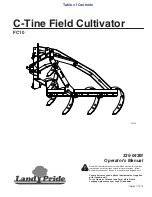
8
Reinstalling Motor and Fan Assembly
See Fig. 12.
1. Align motor harness/grommet at ~7 o’clock (facing
installer) and align the bottom flats on right and left sides
of fan stator with fan deck ribs. Drop fan assembly down
into fan deck opening and slide back until aluminum stator
is under the rear fan deck brackets.
2. Align (if necessary) two front holes and fasten stator to
fan deck with 2 #10 x 5/8-in. hex head screws (P/N:
AL48AM217). Tighten to 50 in.-lb (5.65 Nm).
3. Reconnect wires for stator temperature limit switch.
4. Pull motor harness tight through grommet and plug it in to
the control box harness and secure in the corner with snap-
in wire tie.
Fig. 12 —
Fan Assembly Install
COOLING
Condenser Coil
The condenser coil is fabricated with round tube copper hairpins
and plate fins of various materials and/or coatings (see Model
Number Nomenclature in Appendix A to identify the materials
provided in this unit). The coil may be one-row or composite-type
two-row. Composite two-row coils are two single-row coils fabri
-
cated with a single return bend end tubesheet.
Condenser Coil Maintenance and Cleaning
Recommendation
Routine cleaning of coil surfaces is essential to maintain proper
operation of the unit. Elimination of contamination and remov
-
al of harmful residues will greatly increase the life of the coil
and extend the life of the unit. The following maintenance and
cleaning procedures are recommended as part of the routine
maintenance activities to extend the life of the coil.
REMOVE SURFACE LOADED FIBERS
Surface loaded fibers or dirt should be removed with a vacuum
cleaner. If a vacuum cleaner is not available, a soft non-metal
-
lic bristle brush may be used. In either case, the tool should be
applied in the direction of the fins. Coil surfaces can be easily
damaged (fin edges can be easily bent over and damage to the
coating of a protected coil) if the tool is applied across the fins.
NOTE: Use of a water stream, such as a garden hose, against a sur
-
face loaded coil will drive the fibers and dirt into the coil. This will
make cleaning efforts more difficult. Surface loaded fibers must be
completely removed prior to using low velocity clean water rinse.
PERIODIC CLEAN WATER RINSE
A periodic clean water rinse is very beneficial for coils that are
applied in coastal or industrial environments. However, it is
very important that the water rinse is made with a very low ve
-
locity water stream to avoid damaging the fin edges. Monthly
cleaning as described below is recommended. Rinsing coils in
the opposite direction of airflow is recommended.
ROUTINE CLEANING OF COIL SURFACES
Periodic cleaning with Totaline
®
environmentally balanced
coil cleaner is essential to extend the life of coils. This cleaner
is available from Replacement Components Division as part
number P902-0301 for a one gallon container, and part number
P902-0305 for a 5 gallon container. It is recommended that all
coils, including standard aluminum, pre-coated, copper/copper
or e-coated coils be cleaned with the Totaline environmentally
balanced coil cleaner as described below. Coil cleaning should
be part of the unit’s regularly scheduled maintenance proce
-
dures to ensure long life of the coil. Failure to clean the coils
may result in reduced durability in the environment.
Avoid use of:
• coil brighteners
• acid cleaning prior to painting
• high pressure washers
• poor quality water for cleaning
Totaline environmentally balanced coil cleaner is nonflamma
-
ble, hypo-allergenic, non-bacterial, and a USDA accepted bio
-
degradable agent that will not harm the coil or surrounding
components such as electrical wiring, painted metal surfaces,
or insulation. Use of non-recommended coil cleaners is strong
-
ly discouraged since coil and unit durability could be affected.
Two-Row Condenser Coils
Clean coil as follows:
1. Turn off unit power, tag disconnect.
2. Remove all screws from the top panel except the screws
securing the condenser fan to the top panel. See Fig. 13.
WARNING
UNIT OPERATION AND SAFETY HAZARD
Failure to follow this warning could cause personal injury,
death and/or equipment damage.
This system uses R-410A refrigerant, which has higher
pressures than R-22 and other refrigerants. No other
refrigerant may be used in this system. Gage set, hoses, and
recovery system must be designed to handle R
-
410A
refrigerant. If unsure about equipment, consult the equipment
manufacturer.
1
3
4
2
Summary of Contents for 48JC04-06
Page 15: ...15 Fig 26 Condenser Fan Assembly Screw Pattern Sequence 1 2 3 4 5 NO SCREW Blank Tab...
Page 30: ...30 Fig 52 Integrated Gas Controller IGC Board RED LED STATUS...
Page 64: ...64 APPENDIX D WIRING DIAGRAMS Fig B 48JC 04 06 Control Wiring Diagram...
Page 65: ...65 APPENDIX D WIRING DIAGRAMS Fig C 48JC 04 06 Power Wiring Diagram 208 230 460 3 60...









































